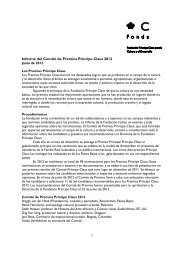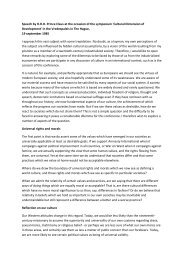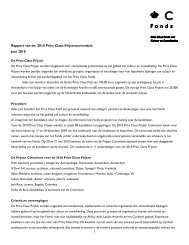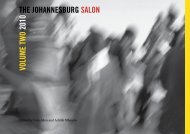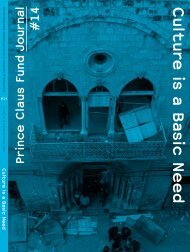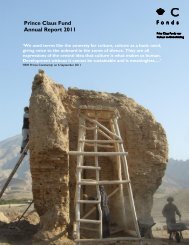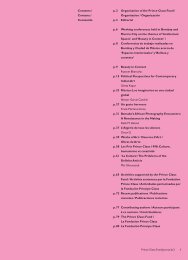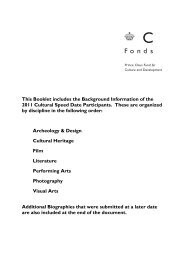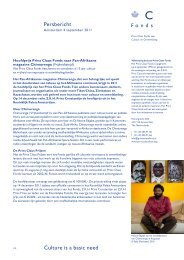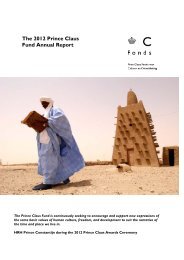3 summer 2011 - Prince Claus Fund
3 summer 2011 - Prince Claus Fund
3 summer 2011 - Prince Claus Fund
- No tags were found...
Create successful ePaper yourself
Turn your PDF publications into a flip-book with our unique Google optimized e-Paper software.
Texture and Diversity:the Cultural Life of the Caribbeanby Rex NettlefordThe textured diversity of Caribbean cultural life is arguably the most significantclue to an understanding and grasp of the dynamism and energy thatcharacterises life in a region that stretches geographically from the Bahamasacross the Greater Antilles (Cuba, Haiti/Santo Domingo, Jamaica and Puerto Rico)proceeding for over a thousand miles southward along an archipelago comprisingthe Leewards and Windward Islands with Barbados a little out of line to the East,then curling round from Trinidad and Tobago to the Netherlands Antilles lyingnorth-west of Venezuela which, like Colombia, insists that it too has a Caribbeancoast. The Guyanas on the South American mainland regard themselves as‘Caribbean’ as would much of Northeast Brazil for definitively cultural reasons.For as I have said elsewhere, the Caribbean shares in the great drama of theAmericas whereby new societies are shaped, new and delicately tuned sensibilitiesare honed, and appropriate designs for social living are crafted through thecross-fertilisation of disparate elements. The process has resulted in adistinguishable and distinctive entity called ‘Caribbean’ and the process isintensely cultural. The encounter of Africa and Europe on foreign soil and they inturn with the indigenous Native Americans on their long-tenanted real estates,and then all in turn with later arrivants from Asia (India and China) and still laterfrom the Middle East (Lebanon), has resulted in a culture of texture anddiversity held together by a dynamic creativity severally described as creativechaos, stable disequilibrium or cultural pluralism. An apt description of thetypical Caribbean person, then, is that he/she is part-African, part-European,part-Asian, part-Native-American but totally Caribbean. To perceive this is tounderstand the creative diversity which is at once cause and occasion, resultand defining point of Caribbean cultural life.This is arguably what makes the Francophone Caribbean, the Ibero- (Spanishspeaking) Caribbean, the Dutch-speaking Caribbean, the British OverseasCaribbean Territories, the US Caribbean (including the Commonwealth of PuertoRico), true kindred spirits despite the differences in linguae francae andpolitical systems. For they all perceive themselves to have in common a full graspof the power of cultural action affording to their inhabitants a sense of placeand purpose. Small wonder that Martinique and Guadeloupe, Curaçao and St.Maarten, Cuba and Santo Domingo along with Haiti, Puerto Rico and the US VirginIslands, as well as the British colonies of the Cayman Islands, the British VirginIslands, Montserrat and the Turks and Caicos Islands identify culturally with thenewly Independent nations – from Belize to Trinidad and Tobago. If theycelebrate their cultural affinities with the wider Caribbean they are no lessaware of the challenges posed by the complexity of the process of managingdiversity. For this demands of all who tenant the Caribbean region the capacityto build bridges not only between classes and races of people within countriesof the region, but also between the continents of the world, themselves allrepresented in the Caribbean through centuries of migration (voluntary andinvoluntary), continuing interaction via tourism, commercial transactions andprofessional contacts.The Caribbean, itself the expression of such diversity and of its survival andbeyond, has struggled for all of five centuries with mastering the management ofthe complexity of such diversity. Such have been the challenges that today it ispossible to say with a fair degree of certainty that the people of the Caribbeanhave learnt to live together rather than simply side by side. In any case thecommunications technology revolution and the tremendous improvement in travelfacilities have dictated the urgent need for people of the 21 st century to learn<strong>Prince</strong> <strong>Claus</strong> <strong>Fund</strong> Reader #1 · Summer <strong>2011</strong> · 66




